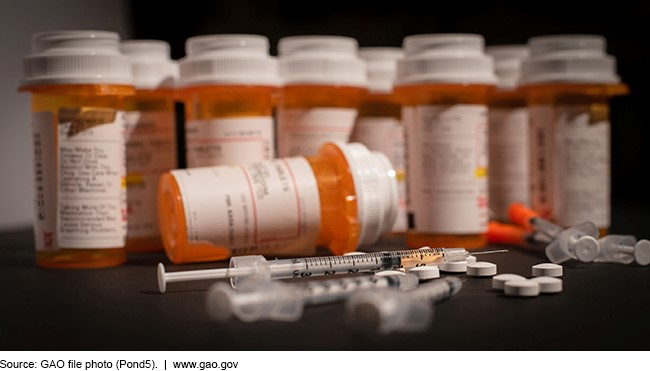FDA Drug Approval: Application Review Times Largely Reflect FDA Goals
Fast Facts
Before a drug can be marketed in the United States, the FDA must determine it is safe and effective. The company or entity seeking to market the drug must submit evidence for review. FDA’s goal is to complete 90% of these reviews within deadlines that vary depending on the drug. Some drugs—ones that may provide significant improvement over what’s available—receive priority designations for expedited reviews.
We reviewed 637 new drug applications submitted from FY 2014-2018 and found the FDA met its goals. Differences in review times among FDA’s 17 divisions were largely driven by the characteristics of the applications being reviewed.

Prescriptions
Highlights
What GAO Found
Four key features of new drug applications (NDA) are linked to the time the Food and Drug Administration (FDA) takes to complete initial reviews of NDAs. Three key NDA features determine the time frames for initial review that would meet FDA's goals under the Prescription Drug User Fee Act (PDUFA) and its reauthorizations, which authorize FDA to collect user fees from drug sponsors:
- Whether or not the NDA qualifies for the priority review program, which is generally an expedited program for drugs that provide significant therapeutic improvements in the prevention, diagnosis, or treatment of a serious condition when compared to available drugs. The PDUFA goal for review of a priority NDA is 4 months less than for an otherwise similar standard NDA, for which the goal is to complete the review in 10 months.
- Whether or not the NDA involves a new molecular entity (an active ingredient that has not been previously marketed or approved in the United States). The PDUFA goal for review of an NDA with a new molecular entity is 2 months longer than for an NDA without one.
- Whether or not the applicant submits a major amendment (additional or new information, such as a major new clinical study) while the NDA is under review. The PDUFA goal for a review of an NDA may be extended by 3 months if the applicant submits a major amendment.
The fourth key NDA feature is whether or not it qualified for one or more of three other expedited programs for drugs intended to treat serious or life-threatening conditions.
GAO's analysis of 637 NDAs submitted from fiscal years 2014 through 2018 indicated that the proportion of NDAs with these key features differed among FDA review divisions. For example, 6 percent of the NDAs reviewed by the dermatology and dental division had a priority designation, compared to 56 percent for the anti-infective division. FDA has reported that some divisions, such as the oncology divisions, generally regulate products for conditions that are more likely to be serious or life-threatening, and, therefore, those products may be more likely to qualify for priority designation and other expedited programs.
GAO found that FDA's divisions differed in the average number of days they took to complete an initial review of NDAs, and these differences largely reflected the key features of the NDAs they reviewed. GAO's analysis shows that the time FDA took to complete an initial review of NDAs was affected by (1) the target time frame for completion of the review under the agency's PDUFA goals, (2) the number of expedited programs for which the NDA qualified, and (3) the division performing the review. GAO also found that the target time frame for review was largely responsible for differences in initial review times. Specifically, NDAs with key features that resulted in shorter target time frames for review under FDA's PDUFA goals had shorter initial review times. Controlling for the effects of these target time frames and the number of expedited programs for which the NDA qualified, GAO found that most of the divisions' average review times were similar to (within 2 weeks of) each other.
Why GAO Did This Study
Before a drug can be marketed in the United States, FDA must determine that the drug is safe and effective for its intended use through a review of evidence that a drug sponsor—the entity seeking to market the drug—submits in an NDA. The review is conducted by one of FDA's divisions (17, at the time of GAO's review) that each specialize in a specific group of drug products, such as hematology products. NDA reviews are complex, and may involve not only an initial review, but also reviews of resubmissions if the initial review does not result in approval. Under FDA's PDUFA commitments, FDA's goal is to complete reviews of 90 percent of NDAs within specific time frames linked to key features of the NDAs.
GAO was asked to examine NDA review times across FDA's divisions. In this report, GAO examines (among other things) differences between FDA divisions in the key features of the NDAs they review and initial review times, as well as the extent to which key NDA features contribute to these differences.
GAO analyzed data from FDA's Center for Drug Evaluation and Research regarding 637 NDAs submitted from fiscal years 2014 through 2018. These data also included biologic license applications submitted to the center. GAO excluded NDAs that were withdrawn by the applicant before FDA completed a review, as well as NDAs for which FDA had not completed a review by March 31, 2019. GAO also interviewed FDA officials about the agency's review process and these review times.
The Department of Health and Human Services provided technical comments on a draft of this report, which GAO incorporated as appropriate.
For more information, contact John Dicken at (202) 512-7114 or dickenj@gao.gov.
